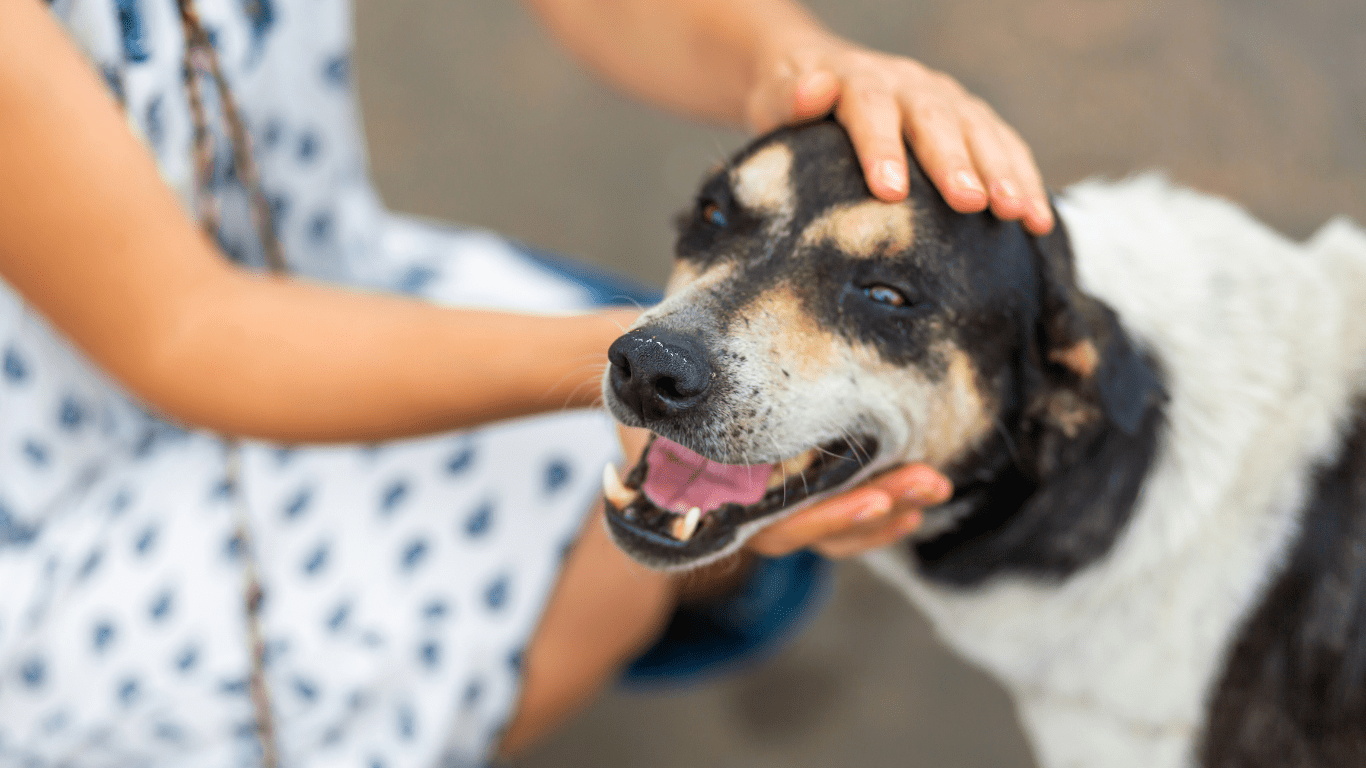Glaucoma in dogs – how can it affect their quality of life?

Glaucoma is a painful eye condition that can lead to blindness in affected dogs. It is complex and may occur for a number of different reasons. If your dog has glaucoma, it can be helpful to understand more about the condition and what the treatment involves. We’re going to explore glaucoma in more detail and the long-term outlook for affected pets.
What is glaucoma?
Glaucoma is a condition that can be seen in dogs, as well as people. Approximately 1 – 2 % of dogs are affected by glaucoma. It occurs when there is an increase in pressure within the globe (eyeball). This is due to an issue with the balance of fluid found there, with an imbalance between the amount fluid entering and the amount being drained from the eye. Normally, the production and drainage of fluid from the eye are well-controlled, to maintain a healthy and stable pressure. In glaucoma, a build-up of fluid occurs, and the intraocular pressure (pressure within the eye) rises.
If this pressure remains elevated for an extended period, it can lead to enlargement of the eyeball and shifting of the lens within the eye. Damage to the optic nerve in the back of the eye also occurs, affecting vision.
There are many different causes for glaucoma, but they can be split into two main types –
Primary glaucoma
Primary glaucoma occurs due to a problem with the eye’s drainage system. It is usually hereditary and so it is more common in certain breeds than others. Primary glaucoma usually starts in one eye before affecting the other later.
Open-angle glaucoma – a painless and gradual process which causes blind spots and loss of vision over a long period. It often affects animals later in life.
Closed-angle glaucoma – is sudden and causes a rapid increase in eye pressure, with more severe symptoms. It usually affects middle-aged dogs.
Secondary glaucoma
Secondary glaucoma is when the condition occurs because of another issue. This could be something like cataracts, a tumour in the eye, trauma to the eye, or uveitis. These eye issues can stop fluid from draining and cause the intraocular pressure to increase. This could affect any breed of dog, at any stage of life. One or both eyes may be affected.
Symptoms of glaucoma in dogs
Glaucoma can be very painful, and it may affect both eyes or just one. Affected dogs may have some or all the following symptoms –
- Squinting or trying to hold their eye closed
- Excessive blinking
- Avoiding bright light
- Acting withdrawn or depressed
- Scratching or rubbing their eyes
- Weepy eyes
- The eye may look cloudy or slightly blue in colour
- Pupils may be of different sizes
- A red or sore-looking eye
- A bulging/swollen eye
- Issues with vision (bumping into things)
- Complete blindness
Glaucoma is an emergency, and you must take your dog to see a vet immediately. Delays in treatment can lead to poorer outcomes and may result in loss of not only sight, but the eye itself.
How is glaucoma diagnosed in dogs?
Your vet will start by examining your dog. They may use an ophthalmoscope, which is an instrument with a light on it that allows the vet to look at your dog’s eye in more detail. A tonometer may then be used, which measures the pressure inside the eyeball. The normal intraocular pressure of a dog’s eye should be 10-25mmHg.
Your vet may need to refer your dog to a specialist ophthalmologist for a more detailed examination. Further tests such as gonioscopy may need to be performed. This requires a special type of lens to look inside the eye to assess primary closed-angle glaucoma. Ultrasound scanning of the eye could also be required.
What is the treatment for dogs with glaucoma?
First of all, it is important to note that glaucoma is not curable, but it can be managed.
Treatment aims to bring down the pressure inside your dog’s eyes. This needs to be done as quickly as possible to limit the damage that can occur.
Initial emergency treatment – Your dog may need to be hospitalised so that your vet can try and reduce the intraocular pressure as rapidly as possible, as well as provide them with strong painkillers. Topical eye drops may be administered, or medications are given systemically. These encourage fluid drainage from the eye.
Ongoing management – Ongoing treatment is required after stabilisation, as glaucoma is a condition that is controlled rather than cured. This may include medical management, surgical intervention, or a combination of both.
Medical management requires eye drops to be administered a couple of times daily. Some dogs may also require systemic medication in the form of tablets. Treatment helps to reduce the amount of fluid that is produced in the eyeball. Regular check-ups and medication reviews with your vet will be required. Even with treatment, most dogs with glaucoma can lose their sight at some point. However, early diagnosis and treatment can help them preserve their vision for as long as possible.
Surgery may be needed in cases that are no longer responding to medical management. This type of surgery will be performed by a specialist veterinary ophthalmologist.
In some cases, the decision may be taken to enucleate (remove the eyeball). This may be recommended if the eye is non-visual (blind), as well as a source of ongoing pain. Many dogs can continue to have a good quality of life following an enucleation.
When to put down a dog with glaucoma
In many cases, glaucoma can be managed, however some cases are trickier than others. As discussed earlier, some dogs may still experience pain and go blind despite treatment, especially if the start of treatment has been delayed. Enucleation could also be advised for end-stage glaucoma in dogs, which can be tricky for some owners to deal with.
Owners may have concerns about their dog’s quality of life. Glaucoma is an extremely painful condition, so if you are unable to afford the recommended care and treatment for your pet, then euthanasia would certainly be the kindest option.
Alternatively, you may find yourself in a situation where, despite intervention, your dog goes blind or requires enucleation. Many dogs can adapt to being blind. Thanks to their keen sense of smell and excellent hearing, they often learn to successfully navigate their surroundings, provided that their routine and home layout are kept consistent. The Canine Glaucoma Foundation has some good tips to help owners manage their blind dogs.
However, if your dog is struggling to adapt to their blindness, then euthanasia may be considered. This is more likely in dogs that have gone blind suddenly and have not had the time to gradually adjust to their loss of vision. If your dog is no longer able to enjoy doing the things that they used to, or if they are becoming withdrawn, depressed or aggressive, then euthanasia is an option for your pet.
If you are struggling to know what to do, then have a look at our ‘Is it time?’ page. We have a checklist that you can work through which will help you to assess your dog’s quality of life further. You can also get in touch with one of our care co-ordinators or your vet to discuss things further.
Summary
Glaucoma in dogs is a true emergency when it occurs, so make sure that you take your dog to a vet immediately if you suspect a problem. Treatment is aimed at controlling the pressure within your dog’s eyes as well as managing their pain. Many dogs will go blind at some point, despite treatment. If you have any concerns about your dog’s quality of life, then make sure you speak to your vet or contact us for further advice.
FAQs
How can I prevent glaucoma in dogs?
Unfortunately, in most cases, glaucoma cannot be altogether prevented as it is a hereditary complaint. Buying a puppy from a reputable breeder or avoiding breeds that are prone to the condition can help. You can take steps to reduce the risk of secondary glaucoma by getting any eye issues seen promptly and avoiding trauma to your pet’s eyes.
What breeds are most prone to glaucoma?
Breeds commonly affected by glaucoma include Cocker Spaniels, Bassett Hounds, Chow Chows, Shar-Peis, Boston Terriers, Beagles and Wire Fox terriers. Choosing a breeder who has screened their dogs for the condition before mating them can help to decrease the chances that your puppy will develop glaucoma in later life.
What are the early signs of glaucoma in dogs?
The early signs of glaucoma can be easily missed. These include sluggish to slightly dilated pupils, a mild increase in redness of the veins in the conjunctiva (membrane around the eye), and mild enlargement of the eye.
Cloud 9
To ensure accuracy, a professional vet has reviewed and verified the information presented in this article. It is important to note that when it comes to making decisions about euthanasia for your pet, there are no easy answers. It is always recommended to seek advice from your own veterinarian before making any decision.


